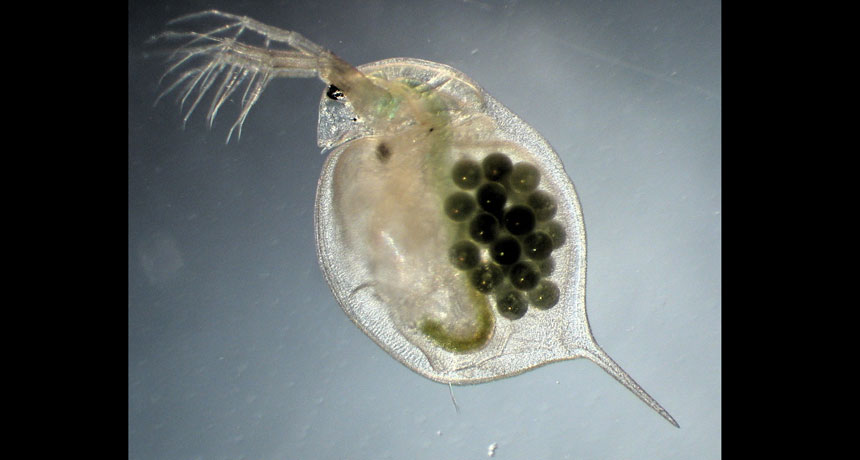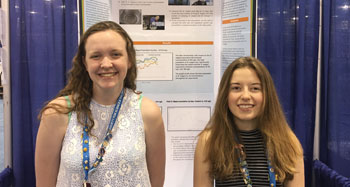Common water pollutants hurt freshwater organisms
Three teens at Intel ISEF find common drugs and germ killers can harm inhabitants of freshwater streams

This tiny creature is called Daphnia magna. It’s a crustacean that lives in freshwaters throughout the Northern Hemisphere.
Dieter Ebert/Wikimedia Commons/CC-BY-SA 4.0
PHOENIX, Ariz. — People are constantly releasing new pollutants into the watery environment. Some may be bits of plastic we can see. Others may be chemicals that wash down the drain or get flushed down the toilet. We may not see those chemicals, but three teens have shown that some polluting wastes can harm freshwater organisms, such as water fleas. But even these can play important roles in watery ecosystems.
Sarayu K. Das, Ella Suzanne Haefner and Elaine Adams presented the results of their research at the Intel International Science and Engineering Fair. Created by Society for Science & the Public and sponsored by Intel, the 2016 competition brought together more than 1,600 students from over 70 countries. (SSP also publishes Science News for Students.)
All three teens studied the tiny creature Daphnia magna — a small freshwater crustacean popularly known as the water flea. (It’s not really a flea, but a relative of shrimp and crayfish.) Although Daphnia may only be a single millimeter (0.039 inch) long, these critters are a large source of food for bigger animals.
A germ-killer floods in
When people try to kill microbes that can cause infection, they may turn to antimicrobials such as triclosan. Many hand soaps and other cleaning products (even toothpaste) may include this widely used chemical. But Ella and Elaine worried that triclosan might harm more than germs. To find out, the 17-year-olds at Loyola High School in Mankato, Minn., put it to the test.

Neither had heard of triclosan before looking for a science fair project. But “it’s being banned in Minnesota in 2017,” Elaine explains. So, she and Ella thought, as a potentially dangerous chemical, “We wanted to test its effect on the environment.”
They decided to use Daphnia as their guinea pig. Being “at the bottom of the food chain, small juvenile fish eat them [the Daphnia],” explains Ella. That makes water fleas a very important indicator species, she says. “If there’s no Daphnia,” she argues, juvenile fish may go hungry and die off. If that happens, she worries, the rest of the ecosystem might suffer.
Triclosan has already been found in streams in the teens’ home state. Ella and Elaine wanted to know whether the levels of triclosan in that water was high enough to hurt water fleas.
They selected concentrations seen in streams of three cities in their state — Duluth, Worthington and Hutchinson. Worthington had the lowest levels — only 18 nanograms of triclosan per liter of water (or 0.018 parts per billion, or ppb). Hutchinson had 0.18 ppb and Duluth had 0.41 ppb. These were well below the triclosan level considered a possible risk to people: 50 ppb.
The teens filled 20 cups with spring water, then placed 10 water fleas in each. They added enough triclosan to reach levels of 18 ppb in five cups, 0.18 ppb in another five and 0.41 ppb in five more. A final five cups contained no triclosan. These served as their controls.
Elaine and Ella monitored the cups for 21 days, counting the water fleas every day. They tracked how many died and how many were born. After the 21 days, the control and the two lower doses had Daphnia that were doing equally well. But a level of 0.41 ppb triclosan proved harmful. Fewer water fleas were born and more died. “It shows that even the levels in our environment today are having an effect,” Ella concludes.
The girls hope their data will raise awareness of risks posed by even low levels of triclosan. “Minnesota is the only state to have banned it already,” explains Elaine. “Canada has banned it. Japan has banned it. It’s on a list of dangerous chemicals for the United Nations, so other countries are aware of it. Banning it across the country will really help the ecosystem as a whole,” she believes.
Drugging up some Daphnia
Ella and Elaine were shocked to hear about triclosan in the water. Sarayu, 15, knows how they feel. This sophomore at Spring Valley High School in Columbia, S.C., was horrified when she heard about discarded medicines ending up in the waters of nearby Congaree National Park.

“Three-quarters of the people I talked to admitted flushing [unused] pharmaceuticals down the toilet,” Sarayu says. Many people think that the way to discard such drugs “is to just place them in the trash or flush them. We don’t think of what happens after we dispose of them.”
She worried about their possible risk to local wildlife. To probe that, she ran tests with two of the drugs found in streams in Congaree National Park. One drug was tri-sprintec, a medicine used to prevent pregnancy. The other was metformin, a drug used to help lower blood-sugar levels in people with type 2 diabetes.
Sarayu tested her drugs on 30 Daphnia, 30 tiny duckweed plants and 10 small apple snails. She put 10 water fleas or 10 duckweed plants into each of three cups of water. She put a single snail into another 10 cups of water. Then, she put enough tri-sprintec to create a concentration of one part per thousand (1 ppt) in one-third of the cups. She created metformin concentrations of 1 ppt in another third of the cups. The rest of the cups — her controls — contained only clean spring water.
Over the next five days, Sarayu counted how many of each organism died. Then, every 5 days she added more drug to the tri-sprintec and metformin cups until they finally reached a concentration of 5 ppt.
The teen used her results to calculate the dose that was high enough to kill half of the organisms. This is known as the lethal dose 50 (LD 50). Three ppt of either metformin or tri-sprintec was toxic enough to kill half of her water fleas, duckweed and snails, she now reports.
Worried by her findings, Sarayu has started an awareness campaign. The teen designed handouts about the dangers of flushing and throwing away old drugs. She now distributes them wherever she can. “The only way this problem can be stopped is through community awareness,” she says.
Power Words
(for more about Power Words, click here)
antimicrobial A substance used to kill or inhibit the growth of microbes. This includes naturally derived chemicals, such as many antibiotic medicines. It also includes synthetic chemical products, such as triclosan and triclocarban. Manufacturers have added some antimicrobials — especially triclosan — to a range of sponges, soaps and other household products to deter the growth of germs.
blood sugar The body circulates glucose, a type of simple sugar, in blood to tissues of the body where it is used as a fuel. The body extracts this simple sugar from breakdown of sugars and starches. However, some diseases, most notably diabetes, can allow an unhealthy concentration of this sugar to build up in blood.
control A part of an experiment where there is no change from normal conditions. The control is essential to scientific experiments. It shows that any new effect is likely due only to the part of the test that a researcher has altered. For example, if scientists were testing different types of fertilizer in a garden, they would want one section of it to remain unfertilized, as the control. Its area would show how plants in this garden grow under normal conditions. And that give scientists something against which they can compare their experimental data.
crustaceans Hard-shelled water-dwelling animals including lobsters, crabs and shrimp.
Daphnia magna Also known as water fleas, these are actually small, freshwater crustaceans. They are near the bottom of the food chain, serving as a major energy source for many small fish.
ecosystem A group of interacting living organisms — including microorganisms, plants and animals — and their physical environment within a particular climate. Examples include tropical reefs, rainforests, alpine meadows and polar tundra.
estrogen The primary female sex hormone in most higher vertebrates, including mammals and birds. Early in development, it helps an organism develop the features typical of a female. Later, it helps a female’s body prepare to mate and reproduce.
freshwater A noun or adjective that describes bodies of water with very low concentrations of salt. It’s the type of water used for drinking and making up most inland lakes, ponds, rivers and streams, as well as groundwater.
guinea pig A rodent (Cavia porcellus) often kept as pets or used in research. Colloquial: A person or other animal that is used as an experimental subject.
hemisphere Half of a globe, which can refer to half of the Earth, half of some ball, or anything else — such as half of the brain.
juvenile Young, sub-adult animals. These are older than “babies” or larvae, but not yet mature enough to be considered an adult.
lethal dose 50 (LD 50) This is the dose of a chemical (which may even be a drug) that kills 50 percent of a treated population. It is a measure used to find out how toxic materials can be to people or animals.
metformin A drug used to treat type 2 diabetes. In this disease, eating food will turn on the production of insulin. This should stop the liver from producing glucose, or blood sugar. But with diabetes, the liver largely ignores the insulin signal, allowing blood-sugar levels to spike to dangerously high levels. Metformin can step in and serve as an alternate agent to signal that the liver should slow or shut off blood-sugar production.
nano A prefix indicating a billionth. In the metric system of measurements, it’s often used as an abbreviation to refer to objects that are a billionth of a meter long or in diameter.
parts per million (billion or trillion) Frequently abbreviated as ppm (or ppb or ppt), it is a measure of the number of units of some material that it mixed into another. The units should be the same (or equivalent) for both materials. The term is used to describing extremely small concentrations of one chemical dissolved in another. For example, a solution of 300 parts per billion of sodium in water would mean that there are 300 sodium atoms for every billion water molecules.
pharmaceuticals Medicines, especially prescription drugs.
sea An ocean (or region that is part of an ocean). Unlike lakes and streams, seawater — or ocean water — is salty.
triclosan A germ-killing chemical added to some common products such as hand soaps and sponges.
tri-sprintec A drug used to prevent pregnancy. It contains the hormone estradiol, or estrogen.
type 2 diabetes (see also diabetes) A disease caused by the body’s inability to effectively use insulin, a hormone that helps the body process and use sugars. Unless diabetes is controlled, a person faces the risk of heart disease, coma or death.







